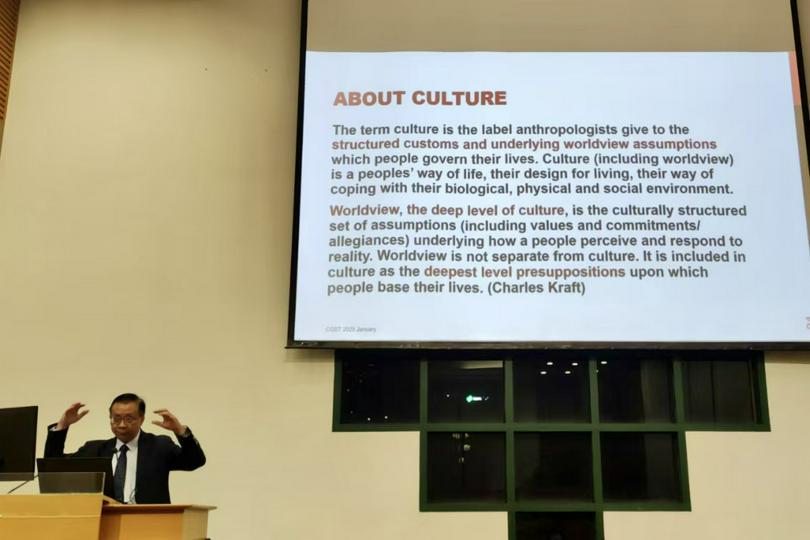On January 23, Dr. Patrick Fung delivered a lecture, titled "Intercultural Leadership and Global Mission," at the Chinese Graduate School of Theology (CGST).
This event was part of CGST's 50th-anniversary celebration and aimed to explore the complexities of intercultural interactions and their impact on global mission work. The lecture series, "Cross-cultural - Josephine So Culture and Ethics Lecture," sponsored by the Josephine Fund on January 23-24, sought to engage scholars and church leaders in discussions on cultural dynamics and ethics.
Dr. Patrick Fung, former general director of the Overseas Missionary Fellowship (OMF) International (2005–2023) and now its global ambassador, began his lecture by expressing his admiration for Chinese culture and emphasizing the importance of understanding diverse cultures. He highlighted the need to delve into cultural nuances and worldview assumptions, using the metaphor of an iceberg to illustrate that visible behaviors are only the tip, while deeper assumptions remain hidden beneath the surface. Drawing on his experience as the chair of a multicultural committee at a recent conference in Seoul, Dr. Fung shared anecdotes that underscored the importance of cultural sensitivity and understanding in leadership and mission work.
Dr. Fung further elaborated on the distinctions between multicultural, cross-cultural, and intercultural contexts. He explained that multicultural contexts involve the coexistence of diverse cultural groups with minimal interaction, where each group maintains its unique cultural identity and practices. As an example, he cited his father's experience of living in Canada for 25 years without speaking English, primarily engaging with other Chinese speakers. Cross-cultural contexts, by contrast, involve active engagement and adaptation between different cultural groups. Intercultural contexts go a step further, requiring deeper understanding, respect, and sensitivity to the values and practices of others. Dr. Fung emphasized that intercultural competence is crucial for effective leadership and mission work.
Expanding on the subject, Dr. Fung explored several cultural dimensions that shape behavior and communication. He discussed power distance, which determines how societies perceive and accept unequal power distribution. For instance, high power distance cultures, such as many in Asia, maintain a clear hierarchy between leaders and followers, whereas low power distance cultures like Switzerland emphasize equality and collective decision-making. Another key dimension he addressed was individualism versus collectivism. Individualistic cultures prioritize personal goals and achievements, while collectivist cultures value harmony and group cohesion. Dr. Fung also touched on uncertainty avoidance, noting that cultures like France and Japan, which score high in this dimension, prefer structured environments with clear rules, while those with lower scores are more comfortable with ambiguity. Finally, he highlighted the distinction between high-context and low-context communication styles. High-context cultures rely on implicit understanding and non-verbal cues, while low-context cultures favor direct and explicit communication. Drawing on his global experiences, Dr. Fung emphasized the importance of recognizing and adapting to these cultural dimensions to foster mutual respect and effective collaboration.
Towards the conclusion of his lecture, Dr. Fung shifted the discussion to the spiritual and missiological aspects of intercultural leadership. Citing Romans 15, he highlighted the indigenous principle, emphasizing the value of trust and partnership in mission work. He advocated for a pluricentric approach—one that centers mission efforts on Christ and the shared mission of the church rather than being dominated by any particular culture. Dr. Fung concluded by emphasizing the significance of Jesus-centered leadership, using the imagery of the shepherd, servant, and steward to illustrate the qualities leaders should embody.
Following Dr. Fung’s lecture, Rev. Edwin Lam, CGST assistant professor, provided a comprehensive reflection on the themes of intercultural leadership and cultural dynamics. He commended the use of diverse analogies to highlight the nuances of cultural complexity. Rev. Lam noted that cultural differences are multifaceted and that leaders must navigate their own cultural contexts while guiding their communities toward a more inclusive and Christ-centered vision. He described leaders as both “prisoners” and “liberators” of culture, tasked with balancing the preservation of cultural identity with the need to foster openness and understanding.
During the Q&A session, thought-provoking questions were posed that sparked insightful discussions among the panelists. For example, one question focused on the development of intercultural mission leaders, particularly in the context of transitioning roles within organizations. A panelist highlighted the importance of formal training, personalized mentoring, and exposure to challenging tasks, citing research that underscores their significance in leadership development. Another question dealt with the practical challenges of cross-cultural ministry in light of rapid demographic changes within churches. A panelist described their experience with a London congregation that had to restructure its support systems to accommodate an influx of Hong Kong families. The panelist stressed the importance of creating safe, inclusive environments and fostering mutual respect to address such challenges effectively.
The session concluded with a reflection on the importance of sensitivity and flexibility in intercultural interactions. The panelists used the metaphor of a rubber band to symbolize the need for adaptability and sensitivity in working together within the framework of a shared mission. The rubber band represents the ability to stretch and accommodate different perspectives and cultural expressions while maintaining the core connection and unity. This image encapsulates the essence of intercultural leadership, where leaders must balance the tension between honoring cultural differences and maintaining a unified vision.












